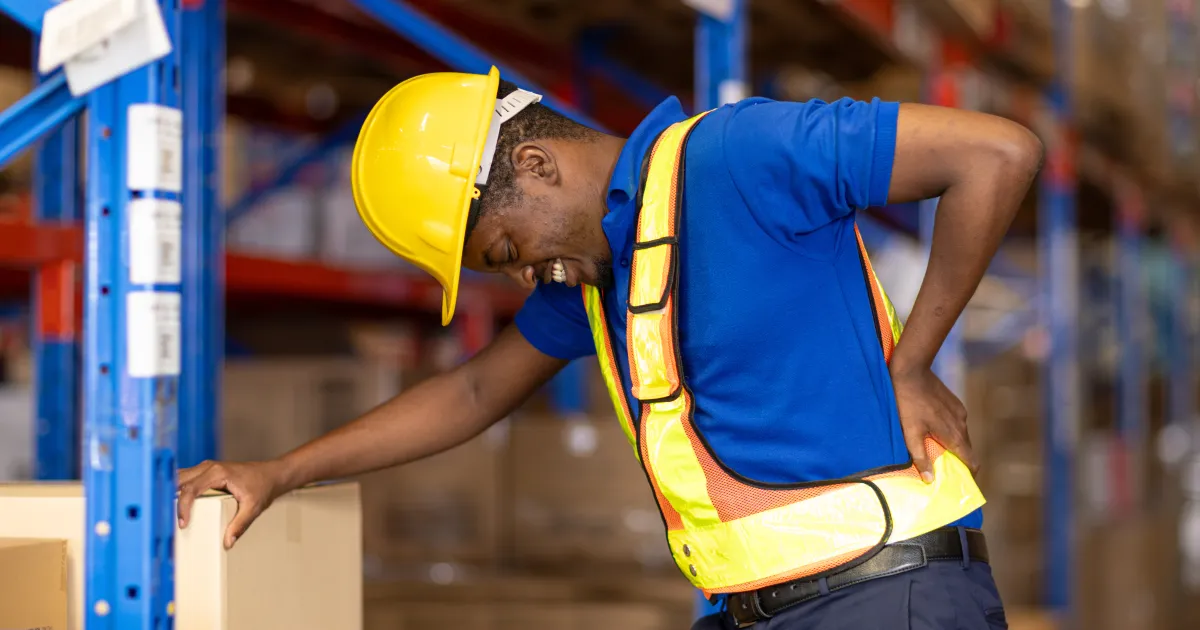Joe's Daily Routine and the Strain of Repetitive Lifting
On Monday mornings, Joe gets out of bed at 5:30 AM and gets ready for the day. After eating his breakfast and having some coffee, he gets in his car and commutes to the cosmetic contract manufacturing facility where he works. He clocks in at 7:00 AM and does the same thing every day until Friday.
For the next 8 hours, Joe spends his day lifting brown cardboard boxes full of shampoo, conditioner, and lotion from the end of a conveyor belt onto a wooden pallet on the ground. He places the boxes into the appropriate places as designated by the corresponding SKU pattern.
Though this task sounds simple enough, day in and day out, Joe’s back aches from endlessly twisting, lifting, and stacking boxes. He suffers from such bad nerve pain that it radiates down both of his legs. He cannot even pick up his toddler anymore due to his ailment, leaving his wife to chase after their young daughter.
Joe is not alone in experiencing this excruciating pain.
Commonality of Overuse Injuries in Manufacturing
Thousands of factory workers experience overuse injuries, with a significant portion of these being lower and upper back injuries. After headaches, back problems are the most common complaint received by healthcare professionals.
Back injuries such as back strains can be caused by single instances of improper lifting or over-stressing the back muscles through twisting or pulling. However, chronic or long-term strains are usually caused by overuse due to prolonged, repetitive movement of the muscles and tendons.
The Lower Back is Easily Injured
The lower back is more prone to injury than other areas of the body because it is responsible for carrying the full weight of the torso. Due to this, the two lowest discs of the spine—the L4 and L5—endure the most strain and are the most likely to herniate. Herniated discs can lead to incredible sciatic pain that radiates down the leg and foot.
For those who perform repetitive motions like Joe, it is common to develop spinal osteoarthritis. This is the breakdown of cartilage in the back, which can cause stiffness of the lower back in the morning and at night, as well as lower back pain that radiates to the pelvis or thighs.
Moreover, excessive repetitive motion can lead to joint instability, which in turn causes small, irregular growths on the bone. Bone spurs can become large enough to entrap nerves that pass through the spinal structure, resulting in intense pain.
Spinal discs can even lose their cushioning and begin to herniate over time. Degenerative disc disease can cause pain that worsens with sitting, lifting, bending, twisting, and the frequent need to switch positions.
OSHA's Revised Lifting Equation and Risk Assessment
To minimize instances of back injuries experienced in manufacturing, OSHA has generated lifting guidelines.
OSHA has created the Revised Lifting Equation (RNLE) as a tool to calculate risk for work-related musculoskeletal disorders. The equation takes into account various factors such as the weight of what is being lifted, the rate and frequency at which it is being lifted, the vertical and horizontal distance the package is being moved, etc.
The Lifting Index (LI) and Its Importance
A component of the NIOSH Lifting Equation is the Lifting Index (LI). The LI measure assesses the risk of injury associated with manual lifting activities by quantifying the physical stress involved in a lifting task and assessing whether it is likely to cause injury, especially to the lower back. The model is based on previous medical research into the compressive forces needed to cause damage to bones and ligaments.
It is important to keep in mind that certain factors may increase the Lifting Index, such as heavier lifting loads (40-50 lbs), lifting from heights close to the ground, lifting boxes above shoulder height, long horizontal carry distances, high-frequency lifts (10+ boxes a minute), awkward positioning, twisting, and duration of a shift.
Feel free to utilize this equation to determine the risk your employees are experiencing when performing a task. However, keep in mind that even comparatively low values provided by the calculator do not remove the risk of injury. Repetitive lifting, regardless of weight and distance, can easily cause musculoskeletal injuries over time.
The Cost of Back Injuries and Workers' Compensation
When employees like Joe get injured, they (or their employer, depending on the state) can then file for workers’ compensation. Depending on the scope of the injury, the financial impact on the employer can vary. The employer may be responsible for insurance premiums, lost wages, medical costs, productivity loss, and/or legal expenses. If the injury results in long-term impairment, settlements can range from thousands to hundreds of thousands of dollars.
According to the National Council on Compensation Insurance’s Workers' Compensation Statistical Plan database, the average compensation costs for lower and upper back injuries between 2021 and 2022 were $40,409 and $37,320 respectively. Although the direct costs of injuries are covered by compensation insurance, injuries can still be incredibly costly for employers.
First, increased injury rates may cause workers’ compensation insurance premiums to increase. However, employers lose most significantly in indirect costs. A study conducted by researchers from the Liberty Mutual Research Institute for Safety, Harvard University, and the University of Wisconsin-Oshkosh found that for every dollar spent on direct costs, about $2.12 would be spent on indirect costs. Indirect costs include reduced productivity, replacement labor, training or retraining, claims management, administration costs, and legal fees. This means that a singular back injury could result in an employer spending over $80,000.00.
Preventing Injuries and Mitigating Costs
For employers looking to avoid paying for costly downtime and increased insurance premiums, there are options. First of all, providing adequate training on how to properly lift boxes to minimize injury is very important. Also, one option is lift tables, which help employees who are palletizing maintain an ergonomic working position. Employees can adjust the height of the load to a comfortable level so they do not need to awkwardly bend, twist, or stretch while lifting. These adjustable lifting platforms reduce the physical stress of repetitive lifting tasks. However, constantly having to adjust these platforms can be time-consuming.
Luckily, there is another option: cobot palletizer systems. This automation completely removes the need for manual palletizing altogether, saving employees from potentially life-altering injuries and saving employers from costly downtime.
Tutor’s turn-key palletizing solution is SKU-adaptable, just like manual palletizing. However, our robots can never get injured. Protect your employees from life-altering back injuries and invest in a palletizing solution today.



